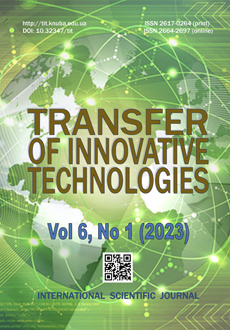Comparison of the influence of the type of acidic environment on the properties of acid-resistant alkali-activated cements
DOI:
https://doi.org/10.32347/tit.2023.61.0107Keywords:
acid resistance, alkaline activated binders, aggressive environment, hydrochloric acid, nitric acid, residual strengthAbstract
The article is devoted to the study of acid resistance of materials developed on the basis of hybrid alkali-activated cements and includes the results obtained during previous studies focused in this direction. This directly concerns the composite compositions of the received cements.
The relevance of the research is ensured by the need of the world market of building materials for modern, effective materials that will retain high acid resistance indicators along with increased physical, mechanical and technological characteristics. After all, as is known, traditional acid-resistant cements based on liquid potassium and sodium glass, although they provide appropriate values of resistance to the influence of an acidic environment, are extremely sensitive to the influence of water, which greatly reduces their service life. And materials based on Portland cement are generally not characterized by acid resistance due to the high content of portlandite (Ca(OH)2), highly basic calcium hydrosilicates and ettringite in the structure of hardened cement stone. That is why alkali-activated systems were chosen as the basis, the experience of working with them confirms the effectiveness of their use in the development of this research area.
In the course of this study, a comparative characterization of the influence of the type of aggressive environment on the processes of structure formation of cement stone and the formation of acid-resistant phases is conducted. 5% solutions of hydrochloric (HCl) and nitric (HNO3) acids were used for the study. The obtained results not only confirm the possibility of using such cements in the conditions of an aggressive environment with a low pH, but also reflect the degree and influence of this type of environment on the material made according to the presented compositions. Thus, the compressive strength of the samples made according to these tested compositions after 90 days of exposure in hydrochloric and nitric acid solutions ranges from 43.1 MPa to 45.7 MPa and from 47.1 MPa to 49.7 MPa, respectively.
References
Koenig A., Dehn F. (2015). Acid Resistance of Ultra High-Performance Concrete (UHPC). Nanotechnology in Constr. 509, 317-323 https://doi.org/10.1007/978-3-319-17088-6_41
Aiken, T. A., Gu, L., Kwasny, J., Huseien, G. F., McPolin, D., & Sha, W. (2022). Acid re-sistance of alkali-activated binders: A review of performance, mechanisms of deterioration and testing procedures. Construction and Building Materials, 342, 128057.
Damion, T., & Chaunsali, P. (2022). Evaluating acid resistance of Portland cement, calcium aluminate cement, and calcium sulfoaluminate based cement using acid neutralisation.. Cement and Concrete Research, 162, 107000.
Hashem, F. S., Amin, M. S., El-Gamal, S. M. A. (2013). Improvement of acid resistance of Portland cement pastes using rice husk ash and cement kiln dust as additives. Journal of thermal analysis and calorimetry, 111(2), 1391-1398
Krivenko P. V. (1992). Spetsialnie shlako-shchelochnie tsementi. Kyiv, Budіvelnik, 192. (in Russian).
Brodko O. A. (1991). Shlakoshchelochnie vyazhushchie i betoni povishennoi kisloto-stoikosti. Dissertatsiya na soiskanie uchenoi stepeni kandidata tekhnicheskikh nauk, Kyiv. (in Russian).
Xu, H., Provis, J. L., van Deventer, J. S., & Krivenko, P. V. (2008). Characterization of aged slag concretes. ACI Materials Journal, 105(2), 131.
Pacheco-Torgal, F., Labrincha, J., Leonelli, C., Palomo, A., & Chindaprasit, P. (Eds.). (2014). Handbook of alkali-activated cements, mortars and concretes. Elsevier.
Provis, J. L. (2018). Alkali-activated materials. Cement and Concrete Research, 114, 40-48.
Zozulynets V. V., Kovalchuk O. Iu. (2022). Perspektyva rozrobky kyslotostiikykh hibrydnykh tsementiv na osnovi luzhnoaktyvo-vanykh viazhuchykh rechovyn. Shliakhy pidvyshchennia efektyvnosti budivnytstva v umovakh formuvannia rynkovykh vidnosyn. Vol. 50, 15-21. (in Ukrainian).
Zozulynets V. V., Kovalchuk O. Iu., Vplyv dodatkovoho vvedennia Na3PO4∙12H2O na pokaznyky kyslotostiikosti hibrydnykh luzhnykh tsementiv. Budivelni konstruktsii: teoriia i prak-tyka, Vol.12, 65-72. (in Ukrainian).
Downloads
Published
How to Cite
Issue
Section
License
Copyright (c) 2023 Viktoriia Zozulynets, Oleksandr Kovalchuk

This work is licensed under a Creative Commons Attribution 4.0 International License.
Our journal abides by the CREATIVE COMMONS copyright rights and permissions for open access journals.
Authors, who are published in this journal, agree to the following conditions:
1. The authors reserve the right to authorship of the work and pass the first publication right of this work to the journal under the terms of a Creative Commons Attribution License, which allows others to freely distribute the published research with the obligatory reference to the authors of the original work and the first publication of the work in this journal.
2. The authors have the right to conclude separate supplement agreements that relate to non-exclusive work distribution in the form in which it has been published by the journal (for example, to upload the work to the online storage of the journal or publish it as part of a monograph), provided that the reference to the first publication of the work in this journal is included.




